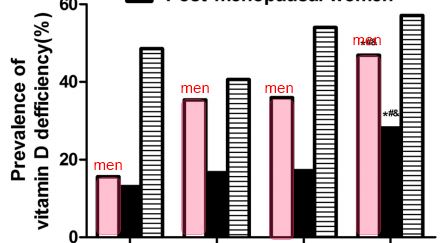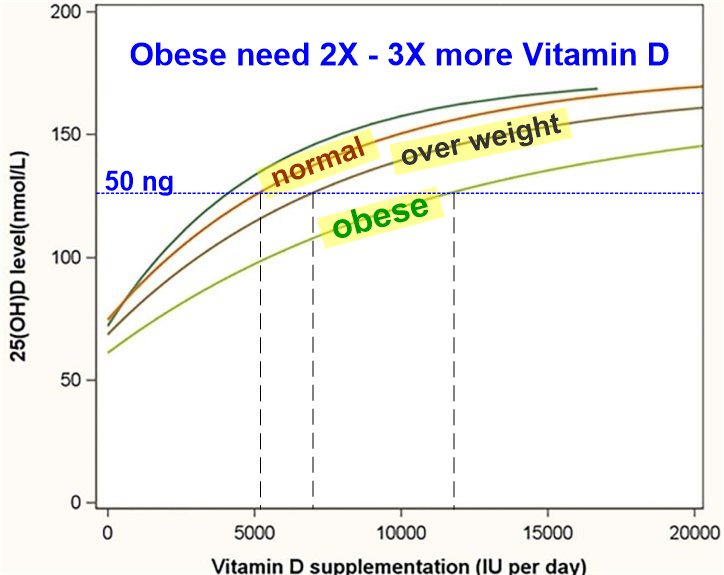Chinese men with high visceral fat were 4.9X more likely to have low vitamin D (under 30 ng)
Higher visceral fat area increases the risk of vitamin D insufficiency and deficiency in Chinese adults.
Nutr Metab (Lond). 2015 Nov 25;12:50.

Caption summary
Prevalence of vitamin D deficiency (<20 μg/L) to the quartiles of visceral fat area in
Men : <90 cm2, 90=116 cm2, 116-140 cm2,: ≥140 cm2
Zhang M1, Li P1, Zhu Y1, Chang H2, Wang X1, Liu W3, Zhang Y3, Huang G1.
1Department of Nutrition and Food Science, School of Public Health, Tianjin Medical University, Tianjin, 300070 China.
2Department of Nutrition and Food Science, School of Public Health, Tianjin Medical University, Tianjin, 300070 China ; Department of Rehabilitation and Sports Medicine, Tianjin Medical University, Tianjin, 300070 China.
3Health Education and Guidance Center of Heping District, Tianjin, 300040 China.
BACKGROUND:
Visceral fat area (VFA), a novel sex-specific index for visceral fat obesity (VFO) might play a major role in the development of vitamin D deficiency. However, the association between VFA and vitamin D insufficiency and deficiency in Chinese population is less clear. The aim of this study was to explore the population-level association between VFA and vitamin D insufficiency and deficiency among Chinese men and women.
METHODS:
This cross-sectional study involved 1105 adults aged 20-70 years living in Tianjin who were randomly selected and medically examined. All subjects underwent the bioelectrical impedance analysis (BIA) method to estimate the VFA. Serum 25-hydroxyvitamin D3 (25(OH) D3) level was assayed by the high-performance liquid chromatography (HPLC) method and defined insufficiency and deficiency following recommended cutoffs. The association between VFA and vitamin D insufficiency and deficiency was estimated using binary regression analysis.
RESULTS:
The total prevalence of vitamin D insufficiency (25(OH) D3: 20-29 μg/L) and deficiency (25(OH) D3 < 20 μg/L) were 26.60 % and 24.89 %, respectively. Significant negative association was observed for VFA with serum 25(OH) D3 levels in men and pre-menopausal women (P < 0.05), not in post-menopausal women (P > 0.05). Moreover, increased VFA was observed to be associated with higher vitamin D insufficiency or deficiency risk with a positive dose-response trend (P for trend < 0.001). As compared to individuals with the lowest VFA, those who had the highest VFA were at 4.9-fold risk of vitamin D insufficiency and deficiency [95 % confidence interval (95 % CI): 1.792-13.365] in men and 1.8-fold risk of vitamin D insufficiency and deficiency (95 % CI: 1.051-3.210) in pre-menopausal women, but not in post-menopausal women [odds ratio (OR) (95 % CI): 2.326(0.903-5.991)].
CONCLUSIONS:
These results suggest that higher VFA increases the risk of vitamin D insufficiency and deficiency in men and pre-menopausal women, but not in post-menopausal women. VFA is a better and convenience surrogate marker for visceral adipose measurement and could be used in identifying the risk of vitamin D insufficiency and deficiency in routine health examination.
PMID: 26612998
📄 Download the PDF from VitaminDWiki
See also VitaminDWiki
Overview Obesity and Vitamin D contains the following summary
{include}
Obesity category listing has items along with related searches and the following chart
Obese need 2 - 3 X more vitamin D (click on chart for details)

All items in categories INTERVENTION AND Obesity
{category}
Most visited 10 pages in Obesity category
{LISTPAGES}
